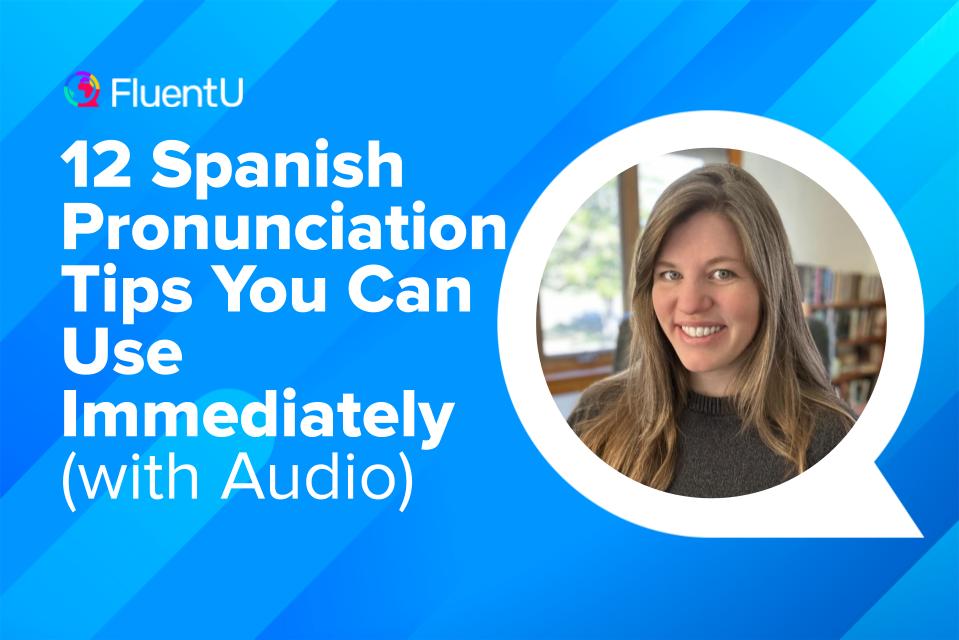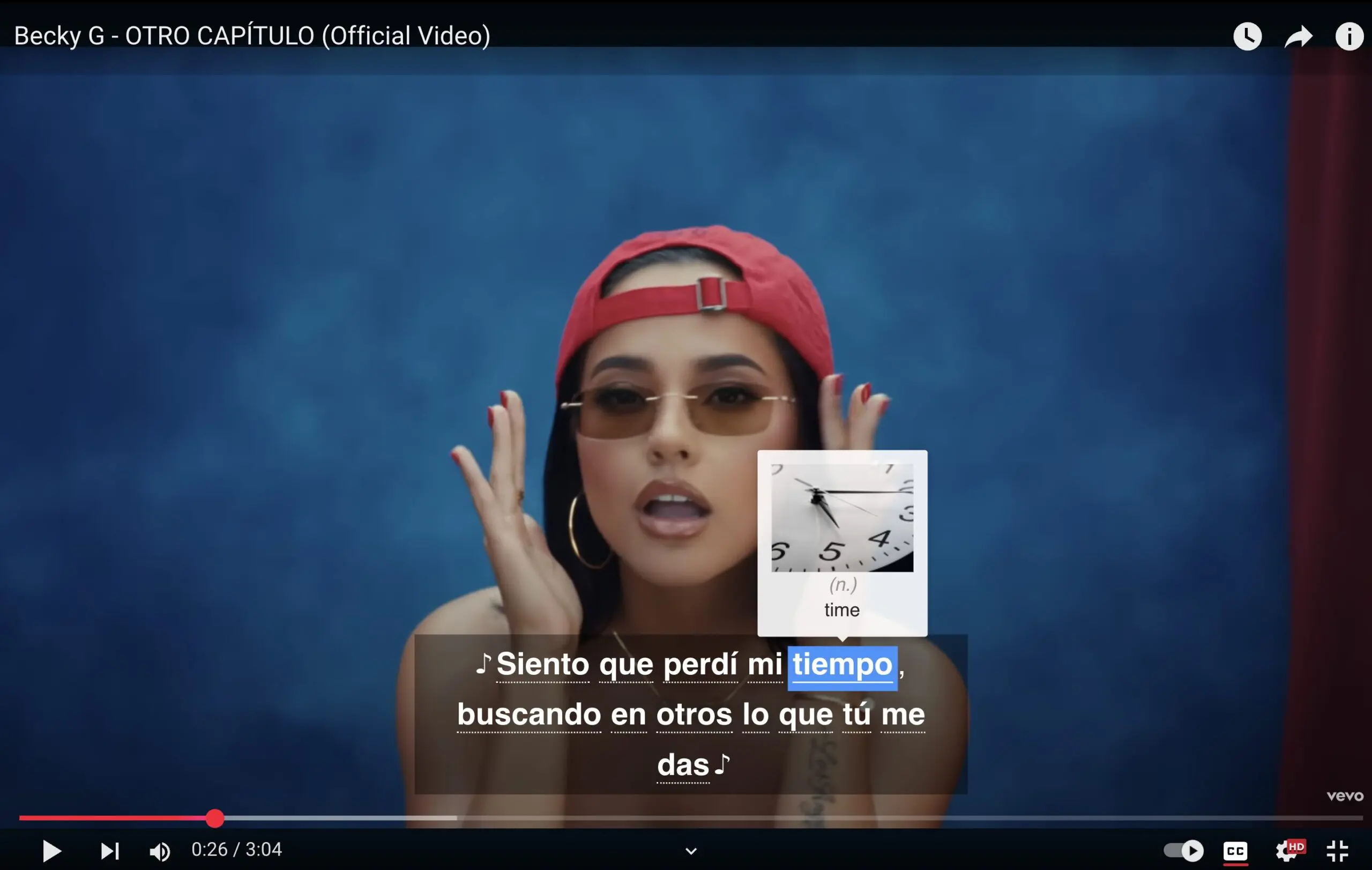Contents
- 1. Avoid over-enunciating consonants
- 2. Spanish vowels are always pronounced the same
- 3. Stress is placed on the last syllable, second-to-last syllable or the accent mark
- 4. B and V sound the same in Spanish
- 5. Cl is pronounced very softly
- 6. C sounds like S when followed by E and I
- 7. D is pronounced very softly
- 8. J is pronounced like H
- 9. G is sometimes pronounced like H
- 10. H is silent in Spanish
- 11. Learn how to roll your Rs
- 12. LL is pronounced like Y
- And One More Thing…
12 Spanish Pronunciation Tips You Can Use Immediately (with Audio)

Want strangers to think you’re from a Spanish-speaking country? Or at least compliment you on how good your Spanish is? Well, you can’t get there without good pronunciation, no matter how fluently you can string together Spanish sentences.
Here are 12 Spanish pronunciation tips you can start practicing right now to sound more fluent.
Download: This blog post is available as a convenient and portable PDF that you can take anywhere. Click here to get a copy. (Download)
1. Avoid over-enunciating consonants
All Spanish consonants follow strict rules for the sounds they make, and there are few exceptions. While many consonants are pronounced the same in Spanish as they are in English, consonants in Spanish are pronounced more softly, so try not to put too much emphasis on them when speaking.
Listen to these words in Spanish, then listen to their English translations:
2. Spanish vowels are always pronounced the same
Spanish vowels always make the same sound, unlike English vowels where a, for example, can be pronounced several ways. Watch the video below several times and practice those vowel sounds until you get them down perfectly:
Once you know what those vowels sound like, you’re set. Just keep in mind that Spanish vowels are pronounced shorter and more clearly than in English.
3. Stress is placed on the last syllable, second-to-last syllable or the accent mark
In Spanish, the second-to-last syllable of a word ending in a vowel, “n” or “s” is the one that’s stressed. For example:
In all words that end in consonants other than “n” or “s,” the final syllable is stressed. For example:
But of course, this changes when there are accent marks. If the word has an accent mark—called a tilde—the stress is placed over the vowel with the tilde.
Accent marks are extremely important to Spanish pronunciation. Misplacing or forgetting an accent can make a big difference in the meaning of your Spanish sentences. For example, esta and está have different meanings and the emphasis is on a different letter in each word.
Pay attention to accent marks and be sure that you place emphasis where it’s needed when you speak, not just when you write.
4. B and V sound the same in Spanish
The difference between b and v in English is obvious, but in spoken Spanish, b and v both sound like b.
I remember the first time I told my Peruvian boyfriend that in English, they make two different sounds. I pronounced B and V over and over again in English and he swore I was saying the same thing because he couldn’t hear the difference!
Take a look at some examples:
Beber (to drink)
Vivir (to live)
Haber (to be)
A ver (to see, let’s see)
Habilidad (ability)
Avergonzar (to embarrass)
This might sound confusing at first, but I promise it gets so much easier with time. The best thing you can do is talk to native speakers and listen to native, authentic content to train your ears to hear the subtle differences. Eventually, your mouth will pick up too.
For this, I recommend using an online program like FluentU.
FluentU takes authentic videos—like music videos, movie trailers, news and inspiring talks—and turns them into personalized language learning lessons.
You can try FluentU for free for 2 weeks. Check out the website or download the iOS app or Android app.
P.S. Click here to take advantage of our current sale! (Expires at the end of this month.)

5. Cl is pronounced very softly
Cl in Spanish is a very graceful, elegant sound that is pronounced softly and swiftly. English speakers spend far too much time attempting to enunciate both the c and the l.
Try saying the English word “clomp.” You likely made a very hard “c” sound and lingered on the “l.” This sound is way rougher in English than in Spanish.
Now let’s try to say claro (clear). Try to reduce the entire cl sound to just half a second. Your tongue should only gently tap the roof of your mouth, and then you quickly and gracefully lilt on to the following a.
Here are some more examples:
Clase (class)
Clave (key)
Clima (weather)
6. C sounds like S when followed by E and I
The letter c will be pronounced like the Spanish letter s when followed by the vowels e and i. For example:
Cesar (to stop)
Cicatriz (scar)
Cerrar (to close)
When followed by the vowels a, o, u or a consonant, you’ll use a hard c. The hard thing is to not say the c as we would in English—strongly with air rushing out of our mouth. For example:
Caro (expensive)
Curar (to heal)
Color (color)
Clavo (nail)
With the Spanish hard c, no air should leave your mouth. Test this out with the Spanish acomodar (to accommodate). No time should be spent lingering on the hard c.
7. D is pronounced very softly
The English d is pronounced extremely deeply (and inelegantly).
When we say a word like “donut,” we open our mouths wide and our tongues loll about. Try saying “donut” and pay attention to your tongue.
In Spanish, we always want to strive to pronounce the Spanish letter d just like the “d” in “didn’t.” This letter “d” tends to stick to the tips of our tongues.
Try using this softer, lighter pronunciation of “d” for the Spanish word donar (to donate). Don’t let that tongue move around! Keep it towards your front teeth.
Here are some other examples:
Derretirse (to melt)
Dominar (to master, get control of)
Delito (crime)
When d comes at the end of a word in the form of –ado or –ada, you’ll probably not even hear the d pronounced fully. For example, pescado sounds more like pescao.
8. J is pronounced like H
The Spanish letter j has a breathy “h” sound, like the “h” in “house.” You may already know this thanks to Spanish loan words in English—for example, how do you pronounce jalapeño ? Exactly: ha-la-payn-yoh.
Here are a few more examples:
Frijoles (beans)
Jalar (to pull)
Ajustar (to adjust)
9. G is sometimes pronounced like H
When the Spanish letter g precedes u, a or a consonant, it’s a bit like the hard English “g” found in “grape,” but a bit softer. For example:
Gallina (hen, chicken)
Galleta (cookie, cracker)
Gusano (worm)
When g precedes i or e, it’s pronounced like the Spanish letter j. For example:
Girasol (sunflower)
Germinar (to germinate)
Girar (to turn)
So, does that mean we pronounce the g sound in guacamole? Nope. It turns out that the pair gu comes with its own set of rules.
When gu is followed by an i, e, or o, like in guerra (war), the g is hard. But if it’s followed by an a, then it makes a whua sound. For example:
Aguacate (avocado)
Guacamole (guacamole)
Guayaquil (a city in Ecuador)
10. H is silent in Spanish
You likely already know that h is not pronounced in Spanish, but it doesn’t hurt to have a reminder. For example:
Almohada (pillow)
Ahora (now)
Hola (hello)
When you see h in a word, pretend it doesn’t exist unless it’s in a ch combo. For example:
China (China)
Chupar (to suck)
Chico (boy)
11. Learn how to roll your Rs
Rolling your Rs is an almost universal struggle for English speakers. But if the majority of Spanish speakers out there can do it, so can you.
A single r should almost sound like the Spanish d or like the English “d” sound in “udder.” It’s on the tip of your tongue, not in the back of your throat like the English letter “r.”
Now, learning the rr tongue roll is going to take a lot of practice. You will essentially vibrate your tongue against the back of your top teeth, much like you do for the tt sound in “butter.”
Just remember that you only do the tongue roll for rr, not a single r.
Here’s a video with some tips on how to do this:
We also have a guide on rolling your Rs, which you can find here:
How to Roll Your Rs in Spanish | FluentU Spanish Blog
Learn how to roll r’s in Spanish with this guide! Are you struggling with the pronunciation of this letter? If so, we have you covered! Here, you’ll find seven tips you…
12. LL is pronounced like Y
Welcome to the only Spanish consonant that I’ll tell you to pronounce more strongly. We have a dainty “l” sound in English that doesn’t exist in Spanish.
This is the delicate “l” you see in “delicate” and “listen.” Feel where your tongue goes when you pronounce these two words out loud. This sound is made with the tippy-top of the tongue lightly pressed against your front teeth.
The Spanish l is much more pronounced as you linger on it a bit longer than you would in English. Your tongue should be pressing against the roof of your mouth to make these sounds, creating a rich, hollow tone.
While you still want to keep your vowels short, you can pause and linger on the letter l in words like hola and loco.
The double ll is a whole different ball game. Generally, it’s pronounced like the English letter “y” in “yell.” For example:
Pollo (chicken)
Llanta (tire)
Llenar (to fill)
Note that this sound can change from region to region.
And there you have it! 12 Spanish pronunciation tips you can start using today. Now that you know which sounds to focus on, you’re on your way to sounding more and more like a native Spanish speaker.
Download: This blog post is available as a convenient and portable PDF that you can take anywhere. Click here to get a copy. (Download)
And One More Thing…
If you want to learn Spanish with authentic materials but need a little extra support, then you need to know about FluentU.
FluentU lets you consume the same content as native Spanish speakers, but with tools to make it easier to pick up the language while you watch. You’ll learn Spanish as it’s actually spoken by real people, unlike programs that use scripted content.
You can bring our learning tools directly to YouTube or Netflix with the FluentU Chrome Extension, or check out our curated video library full of clips that cover a wide range of topics, as you can see here:
FluentU brings native videos within reach with interactive subtitles. You can tap on any word to instantly see its meaning, an image, and its audio pronunciation. Click on the word for additional examples and to add it to your flaschards.
To reinforce what you've learned, you'll complete engaging exercises and see more examples of the key words from the video. FluentU keeps track of the vocab you’re learning, and gives you extra practice with difficult words.
Start using the FluentU website on your computer or tablet or, better yet, download the FluentU app from the iTunes or Google Play store. Click here to take advantage of our current sale! (Expires at the end of this month.)











